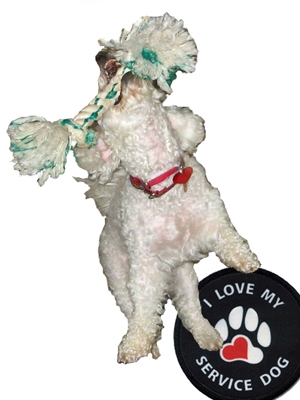ADA Service Dog Changes Effective on Ides of March

The Americans with Disabilities Act (ADA) issued regulations in 1991 to permit the use of a service animals in public. This required modifications in policies in such places as restaurants, hotels, retail establishments, theaters and concert halls. In short, this meant that service animals accompanying persons with disabilities had to be admitted in places that otherwise had policies excluding pets or other animals.
At that time, 20 years ago, most service animals were "seeing eye" dogs that assisted visually impaired individuals. For the most part, guide dogs for the blind were highly-trained, unlikely to create a nuisance or a sanitary problem and to sighted individuals, were obviously providing service to their visually impaired handler. Over time, not only did the function of service animals expand to include assistance for a variety of both visible and invisible disabilities, so too did the number of species being used by people in the name of service. These included pigs, cats, horses,monkeys, snakes, lizards, birds and rodents.
As more and more people were using more and more animals in the context of service work, it became apparent that some changes were necessary. The proliferation of service animals in public settings, some whose poor manners posed obvious problems in public in terms of safety, sanitation and disturbance of others, was becoming a hot button issue for proprietors of retail businesses.
Until now, however, retailers were largely powerless to bar these types of animals from their establishments.
The U.S. Justice Department has issued new regulations effective March 15,2011. Not only will these new regulations substantially limit the types of animals that will qualify as service animals under the ADA to dogs (and miniature horses in some cases), but they help clarify the different definitions and legal entitlements between service dogs and emotional support dogs.
Service dogs' tasks include the following examples:
* assisting sight-impaired persons with navigation or other tasks;
* alerting hearing-impaired persons to the presence of people or sounds;
* providing non-violent protection or rescue work;
* pulling a wheelchair;
* assisting an individual during a seizure;
* alerting an individual to the presence of allergens;
* retrieving items such as medicine or the telephone;
* providing physical support /assistance with balance and stability to individuals with mobility impairments; and
* helping persons with psychiatric and neurological disabilities by preventing or interrupting impulsive or destructive behaviors.
Emotional Support Dogs (ESD) are dogs who provide emotional support, well-being, comfort, or companionship. Wonderful qualities, for sure, but they do not constitute task specific functions and so, under these new definitions, are NOT service dogs. In short, animals that provide only comfort or emotional support for their owners will no longer qualify as service animals.
For a dog to qualify as a psychiatric service dog (PSD) for an owner with a psychiatric disability under the new regulations, the dog must be trained to perform specific work or tasks. Examples include reminding the handler to take medicine, providing safety checks or room searches for persons with Posttraumatic Stress Disorder (PTSD), interrupting self-mutilation, and removing disoriented individuals from dangerous situations. If a dog is used to "ground" a person with a psychiatric disorder, this qualifies as a service animal if the dog has been trained 1) to recognize that a person is about to have a psychiatric episode, and 2) to respond by nudging, barking or removing the person to a safe location until the episode subside. Note that dogs trained to provide aggressive protection (i.e., attack dogs) will NOT qualify as a service dog.
Other important highlights of the new law:
Dog must be under control of handler and show appropriate manners (housebroken, in control and unless prohibitive to function, on a harness, leash or other tether).
If an individual with a disability is asked to remove a service animal from the premises if the animal is neither housebroken or in control, the person with a disability must still be permitted to access the establishment's goods, services or accommodations without the animal being present.
Public accommodation is not responsible for the care or supervision of a service animal.
As to the nature or extent of a person's disability, the public may make 2 inquiries to determine whether the animal qualifies as a service animal (but expected not to if by observation it is obvious the dog is providing function):
1) it may ask if the animal is required because of a disability, and
2) what work or task the animal has been trained to perform.
The public may NOT require documentation, such as proof that the animal has been certified, trained or licensed as a service animal. Nor may a public accommodation require a person with a disability to pay a surcharge for a service animal, even if it applies such a surcharge for pets.
Note that these Federal Laws do NOT apply to landlords or airlines. These entities are governed by the Fair Housing Act and the Air Carrier Access Act, respectively.
In sum, these new regulations give long-needed clarity to hotels, restaurants, retailers and other public accommodations regarding which animals must be allowed as service animals, and under what circumstances.
This important information should be on hand for anyone interested in keeping current on Federal regulations as they pertain to service dogs.




